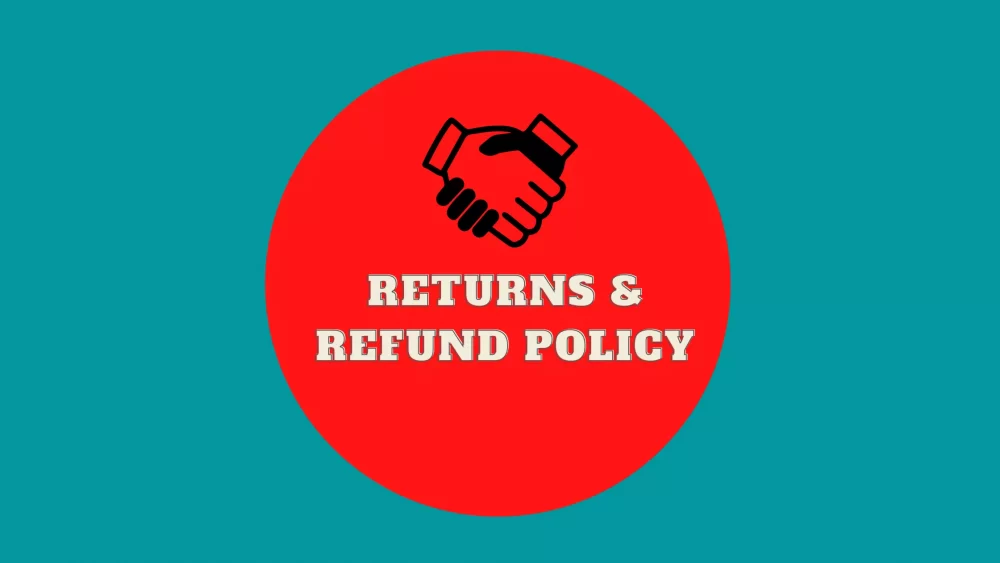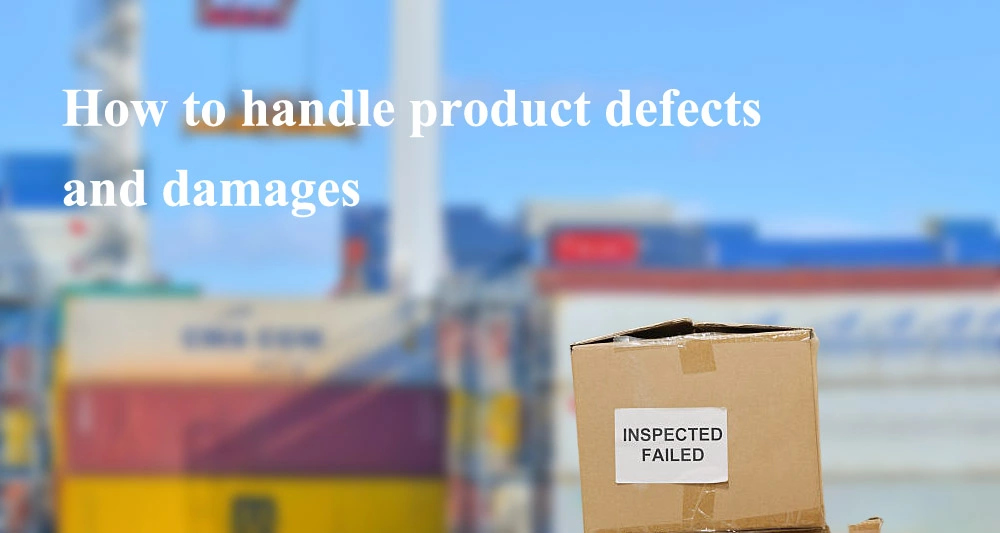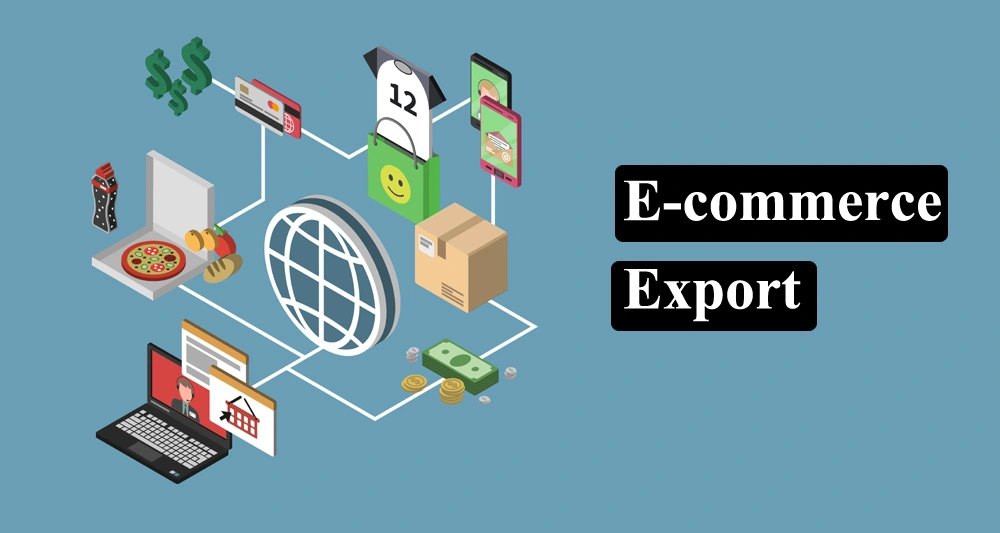What is E-commerce Export ?

E-commerce export is the word used to describe the online sale of products or services to clients in other nations. It entails using digital technology and e-commerce platforms to make cross-border export of goods and services easier. Businesses may reach a worldwide audience and increase their consumer base outside of their native market by using e-commerce export. Also, it makes it possible for customers in other nations to access a broader variety of goods and services from around the globe, sometimes at more affordable costs. Due to the development of digital technology and the escalating globalisation of markets, e-commerce export has grown in popularity in recent years.
Why is E-commerce export important for online businesses?

E-commerce export is important for online businesses for several reasons :
1. Global market access : By using the internet to do business, companies may reach a far larger audience than they might with conventional brick-and-mortar storefronts. This raises the likelihood of sales and income.
2. Opportunities for greater revenue and expansion : By expanding their consumer base through online sales, firms have a greater chance to make sales and generate income. Also, it enables them to spread out their income sources and lessens their reliance on a particular industry or clientele.
3. Cost Savings : As e-commerce does not require physical storefronts and has lower overhead expenses than traditional retail, it may be more economical. Due to increased profit margins, firms may be able to offer clients competitive prices.
4. Enhancing the client experience : E-commerce systems frequently provide features like tailored suggestions, simple checkout procedures, and quick shipment. Customer loyalty and satisfaction may rise as a result.
5. Access to data and insights : E-commerce platforms give companies useful information about consumer behaviour, preferences, and purchasing trends. This can assist companies enhance their overall performance and optimise their marketing and sales tactics.
What are the benefits of exporting products from your online store?

Exporting products from your online store can provide several benefits :
1. Increased revenue : Revenue potential can expand dramatically by exporting goods to other markets, as can your consumer base. You may do this to spread out your revenue sources and lessen your reliance on the domestic market.
2. Competitive advantage : Exporting your goods might provide you an edge over rivals by enabling you to sell specialised or niche goods that are unavailable in some countries. This might make you stand out from the crowd and draw in new clients.
3. Economies of scale : By increasing production volume and lowering unit costs, exporting items can assist you in achieving economies of scale. You may be able to increase your profit margins and provide more competitive pricing as a result.
4. Access to new markets : Selling your goods abroad might provide you access to clients and markets that aren’t always available in your own country. This might assist you in growing your company and looking into potential new markets.
5. Brand exposure : Exporting goods may help you build a more well-known and respected brand internationally. This might assist you in building your brand as an internationally recognised leader in your sector.
What are the challenges you might face when exporting your products?

Exporting products can present several challenges that businesses need to be aware of, including :
1. Regulatory compliance : Compliance with regulations: Exporting goods to other nations may entail navigating complicated regulatory requirements, such as those relating to product standards, labelling specifications, and customs laws. If these rules are broken, there might be expensive penalties, delays, or even goods seizures.
2. Logistics : Navigating challenging supply chain and logistics difficulties, such as shipping, handling, and transportation, is frequently required when exporting goods. Working with several partners and service providers might be involved in this, which can be difficult to organise and manage.
3. Cultural difficulties : Exporting goods to foreign nations may include overcoming linguistic and cultural hurdles. This could include spending a lot of time and money changing marketing and communication tactics to fit regional tastes and cultures.
4. Payment and finance : Managing intricate payment and financing difficulties, such as currency exchange rates, trade financing, and payment methods, is a common challenge when exporting goods. Managing this may be difficult, especially for small organisations with little resources.
5. Political and economic unrest : Exporting goods may be affected by political and economic unrest in target markets, which may result in changes to trade regulations, tariffs, and exchange rate swings. These hazards can be hard to forecast and can significantly affect companies that rely on exporting.
Understanding Export Regulations
What are E-commerce export regulations and why are they important?

The laws and rules that control the export of products or services via online channels, especially e-commerce platforms, are referred to as e-commerce export regulations. These laws are significant for the following reasons :
1. Legal observance : Export controls for e-commerce serve to guarantee that companies abide by pertinent rules and regulations in their target markets. This can contain, among other things, product specifications, labelling rules, and customs laws.
2. Protection of consumers : Export rules for e-commerce make sure that goods sold through online channels adhere to strict safety and quality requirements. This can assist in preventing the sale of items that are fake or subpar and could endanger the health and safety of consumers.
3. Fair competition : By prohibiting unfair trade practises like price dumping or anti-competitive activity, e-commerce export restrictions help maintain fair competition among enterprises.
4. National security : By controlling the export of sensitive technology, such as military or dual-use products, e-commerce export restrictions can assist protect national security interests.
5. Revenue collection : Governments can raise money by collecting tariffs and taxes on imported items with the aid of export rules for e-commerce.
How to comply with E-commerce export regulations?

Complying with e-commerce export regulations involves many of the same steps as traditional export regulations, but there are some specific considerations for e-commerce businesses:
1. Research e-commerce regulations : E-commerce rules should be researched. As e-commerce rules might differ by nation and platform, firms should look into the rules that apply to their platforms and products in their target markets. Rules governing product descriptions, prices, and payment options might fall under this category.
2. Give correct product information : To make sure they are in compliance with local laws, e-commerce companies should provide accurate and comprehensive product information, including descriptions, specs, and price.
3. Ensure secure payment methods : Make sure your payment methods are safe and adhere to local legislation, such as data privacy laws: E-commerce enterprises should make sure that your payment methods are secure and conform with local laws.
4. Customers and partners should be screened : E-commerce enterprises should check to see whether any of its customers or partners are on any restricted or denied party lists. Those who are sanctioned by the government, as well as private citizens or organisations, may fall under this category.
5. Protect customer data : Customer data should be protected, and online retailers should adhere to regional data privacy laws like the General Data Protection Regulation (GDPR) in the European Union.
6. Establish compliance processes : To make sure they are adhering to export laws, e-commerce companies should develop internal procedures. This might involve educating staff members about requirements, carrying out routine audits, and maintaining thorough records of all transactions.
Identifying Export Markets
How to identify potential E-commerce export markets?

Doing market research and analysis to find places where there is a need for your items and where you can successfully compete is necessary for identifying possible e-commerce export markets. These are some actions to take :
1. Examine your offering : Analyze your product first to pinpoint its special qualities and advantages. Price, quality, and conformity with regional laws and cultural preferences are important considerations.
2. Research potential markets : Utilize web tools like trade associations, government databases, and market research papers to explore possible markets for your product. Take into account elements that may affect customer choices, such as population size, GDP, e-commerce adoption rates, and cultural elements.
3. Consider the competitors : Consider the local and international e-commerce companies providing comparable items as well as the competition in each prospective market. Think on elements like price, marketing, and distribution plans.
4. Analyze shipping and logistics : To make sure you can successfully and efficiently distribute your items to clients, analyse the shipping and logistics infrastructure in each possible market. Take into account elements like shipping expenses, delivery schedules, and customs laws.
5. Review payment alternatives : To be sure you can receive payments in a way that is easy for customers and in compliance with local laws, review the payment methods offered in each prospective market.
6. Consider cultural and linguistic factors : Take into account cultural and linguistic aspects that might affect your capacity to promote and sell your items successfully in each target market. This may involve elements like language, cultural customs, and regional holidays.
Preparing Your Products for Export
What are the requirements for exporting products?

Compliance with many legal, regulatory, and logistical standards is necessary when exporting goods from one nation to another. These are a few standard prerequisites for exporting goods :
1. Get the required licences and permits: Depending on the product and the nation you are exporting to, you might need to acquire a number of licences and permits, including an export licence, an import licence, or a health certificate. To find out the specifications for your particular product, get in touch with the relevant governmental organisations or trade groups.
2. Respect customs laws: You must respect the customs laws of both your own country and the nation you are exporting to. This involves providing accurate paperwork, properly labelling and packing your items, and paying all necessary taxes and customs.
3. Ensure product compliance: Make sure your items are compliant with the destination nation’s safety, health, and environmental regulations. To make sure your goods comply with all relevant regulations, check with regional regulatory bodies and industry groups.
4. Consider logistics: Exporting items need thorough preparation to guarantee their timely and safe arrival at their destination. To secure your items while shipping, you will need to make arrangements for transportation, insurance, and appropriate packing.
5. Develop relationships with buyers: Building relationships with potential buyers in the destination country is crucial for successful exporting. This involves conducting market research, identifying potential customers, and developing a sales strategy.
How to package your products for export?

Packaging your products for export requires careful consideration to ensure that they are protected during transportation and arrive at their destination in good condition. Here are some tips for packaging your products for export :
1. Employ strong and resilient materials: Use materials that can survive the stresses of transportation, such as corrugated cardboard, wood, or plastic. Useless materials, such as paper or thin plastic, should be avoided.
2. Employ the right cushioning: To protect your goods from shocks and vibrations during transit, use cushioning materials like foam, bubble wrap, or air pillows. To prevent the items from shifting inside the container, pack them securely.
3. Label and mark the package: The product name, amount, and any other pertinent information, such as the product’s fragility or the presence of hazardous ingredients, should all be clearly marked on the packaging. Include the destination address and any specific handling instructions on the package as well.
4. Respect export laws: Verify that your packaging respects export laws in both your home country and the country of destination. This entails adhering to safety, environmental, and hazardous material labelling requirements.
5. Consider temperature and humidity: Aspects like temperature and humidity should be taken into account when choosing packing materials for items that are susceptible to such conditions. To guard against moisture, you might need to utilise desiccant packs or insulated packaging.
6. Check the packaging: Check the packaging to make sure it can endure the demands of transportation before exporting your items. You can find any packaging flaws and make the required corrections by conducting drop testing and vibration tests.
What are the labeling requirements for exported products?

The labeling requirements for exported products vary depending on the product and the destination country. However, there are some general guidelines that apply to most products. Here are some of the labeling requirements for exported products:
1. Product name and description: To help buyers quickly acknowledge the product, the product name and description should be precise and understandable.
2. Country of origin: The product should be properly labelled with its country of origin so that consumers are aware of where it was manufactured.
3. Weight and dimensions: The product’s weight and dimensions should be clearly labelled so that purchasers can assess the item’s size and number.
4. Ingredients and materials: The product should be properly labelled if it includes any potentially hazardous substances or materials. In certain circumstances, the marking may have to adhere to particular rules, such as those for food or medical items.
5. Handling instructions: If the product requires special handling or storage instructions, they should be clearly labeled. For example, perishable items may need to be labeled “keep refrigerated.”
6. Language: The marking must be in the national tongue of the recipient nation. Language marking may be necessary in some nations.
7. Respect for local laws: The marking must abide by all local laws in the country of destination. This may involve specifications for the typeface, color, and other particular marking components.
Shipping Your Products
How to choose a shipping method for e-commerce export?

When selecting a shipping method for your exported goods, you must take a number of things into account, such as the size and weight of the goods, the destination nation, the necessary delivery time, and the price. When selecting a shipping option, keep the following points in mind:
1. Size and weight of the goods: The most suitable delivery option will be chosen based on the size and weight of the goods. For instance, heavier and larger products would need to be carried by air or sea, but smaller items might be delivered by mail or a courier service.
2. Delivery deadline: The deadline for delivery is a crucial consideration when selecting a shipping method. Generally speaking, air freight is more expensive but also speedier than marine freight. Although they could be more expensive than conventional delivery choices, postal or courier services can provide accelerated shipment options.
3. Country of destination: The choice of shipping method may be influenced by the country of destination. It’s crucial to do your study on the particular needs of the destination country because certain nations may have limits on particular product categories or shipping techniques.
4. Budget: Depending on the method used, shipping charges might vary widely. It’s crucial to take into account the whole cost of exporting the goods before selecting a shipping strategy that is both affordable and dependable.
5. Insurance and tracking: Evaluate the insurance and tracking options that are offered with each shipment service. Certain techniques could provide more in-depth tracking and insurance alternatives than others.
6. Customs clearance: Because some shipping methods may call for more involved customs clearance processes, it’s crucial to factor in the extra time and money these processes would need.
Dealing with Currency Exchange
How to manage currency exchange when exporting products?

Managing currency exchange when exporting products is an important aspect of international trade. Here are some tips for managing currency exchange:
1. Recognize the exchange rate: It’s critical to recognise the exchange rate between your currency and the currency of the destination nation before engaging in any international commercial transactions. As exchange rates can change over time, it’s crucial to keep track of the most recent figures.
2. Choose a payment method: For transactions involving international commerce, a number of payment options are accessible, including wire transfers, credit cards, and PayPal. Every approach has advantages and disadvantages, so it’s crucial to pick one that is dependable and secure.
3. Take into account currency hedging: This strategy entails taking measures to reduce the impact of currency fluctuations on your company. This can entail locking in a beneficial exchange rate using financial instruments like forwards or options contracts.
4. Work with a foreign exchange provider: Working with a foreign exchange provider can help you manage currency exchange by supplying services like currency hedging and payment processing as well as guidance on currency changes.
5. Monitor currency exchange rates: Even after a trade transaction is finished, it’s crucial to keep an eye on currency exchange rates to make sure you are receiving the greatest exchange rate available for your money. By doing this, you may increase your earnings while reducing the effects of currency swings.
How to minimize currency exchange risks?

Minimizing currency exchange risks is an important part of managing international trade. Here are some tips for minimizing currency exchange risks:
1. Choose a stable currency: It’s critical to use a stable currency for international commerce transactions that is less likely to undergo substantial volatility. By doing this, currency exchange risks may be lessened.
2. Hedge currency risks: Hedging entails taking precautions against the risks associated with currency exchange. This can entail locking in a beneficial exchange rate using financial instruments like forwards or options contracts.
3. Use local currency: Consider using the local currency of the destination country for transactions, if at all possible. This can reduce the risks associated with currency exchange and eliminate the need for numerous currency conversions.
4. Monitor exchange rates: Keep a constant watch on currency rates, and be ready to modify your company strategy as necessary. By doing this, currency exchange risks may be lessened.
5. Collaborate with a foreign exchange provider: To assist control currency exchange risks, think about collaborating with a foreign exchange provider. A supplier may give choices for currency hedging, guidance on currency changes, and payment processing services.
6. Negotiate payment terms: Consider discussing the conditions of payment with your overseas commercial partners. For instance, you might be able to set up periodic payments rather than a single payment, which can assist lessen the impact of foreign exchange risks.
Managing Payment
What are the payment options for international customers?

There are several payment options available for international customers, including:
1. Wire transfers: For overseas transactions, wire transfers are a typical form of payment. It entails an immediate transfer of money from the buyer’s bank account to the seller’s bank account.
2. Credit card: Payments made using credit cards are frequently accepted in international trade. International credit card transactions, however, can incur extra costs.
3. PayPal : PayPal is a well-liked online payment system that is frequently used for cross-border purchases. It provides a simple and safe method for sending and receiving money.
4. Letter of credit: A letter of credit is a type of payment guarantee given by a bank that assures the seller of payment following the fulfilment of specific requirements, such as the delivery of the goods.
5. Bank draft: A bank draught is a cheque that has the promise that the bank will pay it when it is presented.
6. Escrow service: An escrow service is a third-party service that keeps money in a trust account until the goods are delivered and the consumer is happy with the deal.
7. Cryptocurrencies: More and more international transactions are being conducted using cryptocurrencies like Bitcoin and Ethereum. They are not yet universally acknowledged, though, and their worth might change significantly.
It’s crucial to take security, practicality, and any applicable costs into account when selecting a payment method for overseas consumers. Also, it’s critical to confirm that the chosen payment method conforms with all relevant rules and regulations and is authorized in the destination nation.
How to avoid payment fraud?

Payment fraud is a serious concern in international trade. Here are some tips for avoiding payment fraud:
1. Verify the identity of the buyer: It’s critical to check the buyer’s identity before engaging in any transaction. Checking their company’s registration and running a background check are two examples of this.
2. Use secure payment methods: Avoid methods like money orders or Western Union transfers that might be more vulnerable to fraud and instead use secure payment methods like wire transfers, credit cards, or PayPal.
3. Be cautious of unsolicited inquiries: Be aware of incoming queries from buyers: Be cautious of incoming inquiries from buyers, especially those who offer to pay a sizable amount up front or who hasten the deal. These might be indicators of corrupt behavior.
4. Do your due diligence: Exercise diligent diligence Be sure to do a comprehensive background check on the buyer, looking at things like their credit history and professional standing. This might aid in spotting any cautionary tales or red flags.
5. Use a trusted third party: Consider employing a dependable third party, such as an escrow company, to manage the money transaction. This might make the transaction more secure and safeguard both parties.
6. Watch for symptoms of fraud: Keep a constant check on your accounts and be on the lookout for any indications of fraud, such as unauthorised charges or shady transactions.
You may defend yourself against payment fraud in international commerce by confirming the buyer’s identity, utilising secure payment methods, being wary of unsolicited queries, performing your due diligence, working with a reliable third party, and keeping an eye out for fraudulent activities.
Dealing with Returns and Refunds
What are the return policies for exported products?

Return policies for exported products will depend on the specific terms agreed upon between the seller and the buyer. However, here are some general guidelines that may be useful:
1. Clearly describe return policies: Ensure that the sales agreement has a clear definition of the return rules for exported goods. This should state the conditions that allow refunds, the window for returns, and any fees that could apply.
2. Provide clients with an acceptable return period: Provide customers with a reasonable return period, such as 30 days. They will have enough time to examine the goods and determine if they want to keep them thanks to this.
3. Provide clear instructions for returns: Giving clients clear information on how to begin a return, together with the required paperwork and shipping guidelines, is important.
4. Inspect returned products: Products that have been returned should be thoroughly inspected to make sure they are still in the same condition as when they were sent. This will assist in preventing fraudulent returns and guarantee that clients get a just refund.
5. Determine responsibility for shipping costs: Decide who is responsible for paying the shipping expenses involved with returns, including both return shipment and delivery to the client.
6. Think about allowing exchanges: Think about allowing consumers to swap items rather than returning them for a refund. This can lower the price of handling returns and preserve goodwill with consumers.
You can contribute to ensuring a fair and effective return process for exported products by clearly defining return policies, providing a reasonable return window, outlining clear instructions for returns, inspecting returned goods, allocating responsibility for shipping costs, and providing exchange options.
What are the refund procedures for exported products?

Refund procedures for exported products will depend on the specific terms agreed upon between the seller and the buyer. However, here are some general guidelines that may be useful:
1. Discover the refund’s justification: When a consumer requests a refund for an exported good, discover the refund’s justification. This might assist in locating any problems that need to be fixed with the goods or the delivery procedure.
2. Inspect the returned product: Make sure the returned item is in the same condition as when it was shipped by carefully inspecting it once it has been delivered. This will assist in preventing fraudulent returns and guarantee that clients get a just refund.
3. Calculate the refund amount: Calculate the refund amount, which may include the product’s price and any applicable delivery charges. Make sure the buyer understands the exact amount of the return.
4. Release the Refund: Release the Refund using the pre-agreed payment mechanism after the Refund Amount has been established. This might be done by a wire transfer, credit to the customer’s account, or a credit card refund.
5. Revise records: Make the necessary changes to your records to reflect the refund, together with any related fees and shipping expenses.
6. Process improvement: Take advantage of the refund procedure to pinpoint any areas in which your procedures might be strengthened. This can enhance client satisfaction and help avoid more refunds.
You may contribute to ensuring a fair and effective refund procedure for exported items by evaluating the cause for the refund, examining the returned product, determining the refund amount, issuing the refund, updating records, and enhancing processes.
How to handle product defects and damages?

Handling product defects and damages is an important part of the export process. Here are some steps to follow when dealing with product defects and damages:
1. Identify the defect or damage: Determine the issue by evaluating the goods or going through any images the customer has given when they report a flaw or damage.
2. Establish the cause: Establish the reason for the flaw or damage, which may include manufacturing, packing, or shipping problems.
3. Evaluate the effect: Evaluate the effect of the flaw or damage, taking into account its gravity and the quantity of impacted products.
4. Communicate with the customer: Interact with the client: Interact with the client to explain the flaw or harm and go over potential fixes. This can entail providing a different product, a reduced refund, or a complete refund.
5. Implement remedial action: Deal with the issue that caused the flaw or harm. This might involve enhancing the production, packing, or shipping processes.
6. Keep an eye out for potential problems: Keep an eye out for potential problems and take proactive steps to stop the occurrence of similar flaws or harm.
Establishing a Support System
How to establish customer support for international customers?

Establishing customer support for international customers is an important aspect of exporting products. Here are some steps you can take to establish effective customer support for international customers:
1. Choose a communication method: Opt for a channel of communication that your clients in other countries can use, such live chat, phone, or email.
2. Determine availability: Establish hours of operation that take into account the time zones of your overseas clients and the availability of your customer care staff.
3. Train customer support staff : Teach your customer service representatives to manage questions from overseas clients, especially those including language hurdles, cultural variances, and time zone discrepancies.
4. Information about products: Give thorough product details, such as product specs, delivery details, and return policies, on your website.
5. Provide multilingual help: To meet the demands of your foreign clients, think about providing multilingual support. This might entail providing translation services or employing personnel who are able to communicate in the languages of your target markets.
6. Use technology: Make use of chatbots, automatic response systems, and knowledge bases to improve customer service.
7. Monitor customer satisfaction: Use customer feedback to keep an eye on client satisfaction and take appropriate action to resolve any problems or difficulties.
You may start a successful export business and create enduring connections with clients abroad by adhering to best guidelines and taking proactive steps to reduce risks and solve problems like payment fraud, defective products, and customer complaints. To keep your export firm competitive and compliant, it’s also critical to stay up to speed on the most recent laws and market trends.
